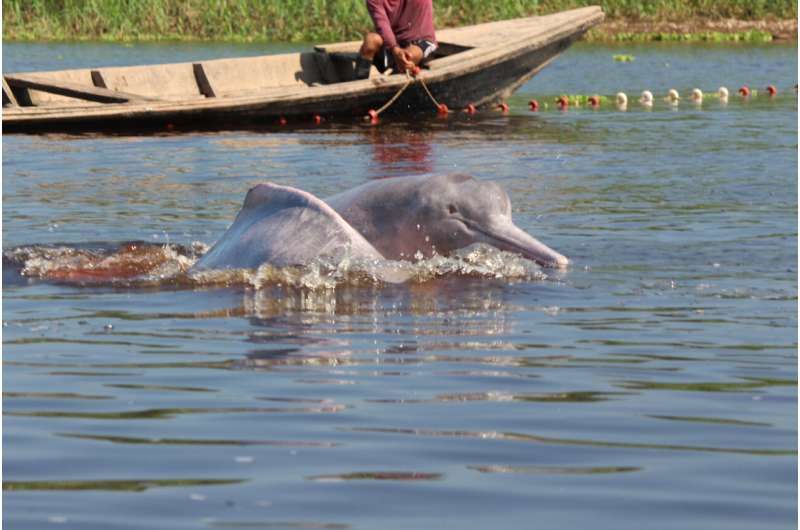This article has been reviewed according to Science X's editorial process and policies. Editors have highlighted the following attributes while ensuring the content's credibility:
fact-checked
peer-reviewed publication
trusted source
proofread
Amazon dolphins at risk from fishing, dams and dredging

Research shows Amazon river dolphins are under threat from fishing and proposed new dams and dredging. Scientists have used satellite tags to track eight dolphins in the Peruvian Amazon, to discover where they went in relation to fishing areas and proposed dams and dredging sites.
On average, 89% of the dolphins' home "range" (the area they live in) was used for fishing. Dolphins were found to be an average of 252km from the nearest proposed dam and 125km from the nearest proposed dredging site.
While these are significant distances, the dolphins' ranges spanned over 50km on average, and dams and dredging can affect large stretches of river habitats.
Additionally, many Amazon river dolphins—already an endangered species—live closer to the proposed sites than the seven males and one female tagged in this study.
The research was carried out by the University of Exeter and Peruvian conservation organization Pro Delphinus. The paper, published in the journal Oryx, is entitled "Satellite-monitored movements of the Amazon River dolphin and considerations for their conservation."
"It's clear that the Amazon river dolphin is facing increasing threats from humans," said Dr. Elizabeth Campbell, of the Center for Ecology and Conservation on Exeter's Penryn Campus in Cornwall. "Fishing can deplete populations of the dolphins' prey, and dolphins are also at risk from intentional killing and bycatch (accidental catching).
"Bycatch has been known to be a threat to these dolphins for the last 30 years, but there's no real data on how many dolphins are caught per year."
The construction of dams, mainly in Brazil, is an expanding threat, with 175 dams operating or under construction in the Amazon basin, and at least 428 more planned over the next 30 years. Additionally, the Amazon Waterway has been approved and is under contract for construction.
This will involve dredging sites across four main rivers of the Amazon basin, and the expansion of ports to facilitate ship navigation across the Amazon, Ucayali and Marañón rivers.
But the researchers say the Peruvian government has an opportunity to protect biodiversity.
"Peru has a chance to preserve its free-flowing rivers, keeping them a safe and healthy habitat for river dolphins and many other species," Dr. Campbell said. "Given that many of these dams and dredging projects are still in the planning stage, we advise the government to consider the negative effects these activities have already had on river species elsewhere."
Dr. Campbell added, "River dolphin tracking programs should now be expanded to span multiple seasons, to track more females at our study sites and to increase the numbers tracked in other areas to improve our knowledge of the movement patterns of this species."
The Amazon River dolphin is found throughout the basins of the Amazon and Orinoco Rivers and is categorized as Endangered on the IUCN Red List.
More information: Satellite-monitored movements of the Amazon River dolphin and considerations for their conservation, Oryx (2023). DOI: 10.1017/S0030605322001557
Journal information: Oryx
Provided by University of Exeter

















